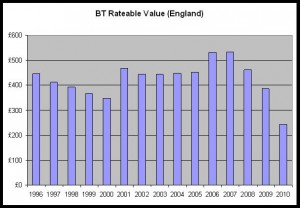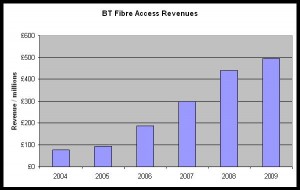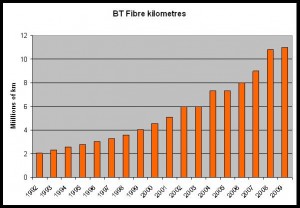The Digital Dales Colloquium was held at Timico HQ in Newark on Friday and packed out the main lecture theatre. With the focus of how to get rural areas onto the internet much of the meeting was spent debating the lack of level playing field when it comes to bidding for projects that involve European funding.From a third party perspective BT appears to have much of this stitched up because their existing deal on rates paid for their network infrastructure is based on a volume play. This means that BT can assume lower costs for fibre runs where new market entrants putting fibre in the ground perhaps for the first time incur much higher charges. The chart below, pinched from network provider Vtesse Networks MD Aidan Paul’s presentation, shows how the rates applied to fibre vary depending on how many fibres you have in the ground on a given route. Clearly if you are an incumbent operator with a large market presence this method of rating is going to give you a significant competitive advantage over a new player. The figures represent rateable value applied to each kilometre of fibre.

The weird nature if the curve doesn’t inspire confidence. Moreover as a separate discussion point these rateable values are quite high numbers and in my mind represent an impediment to the competitiveness of UK plc in general. What is more surprising is that despite the growth in BT’s fibre business the actual rateable value of the corporation has dropped considerably. Your guess is as good as mine as to why this is though no doubt BT has very competent staff involved in its negotiations with the Valuation Office.



Vtesse has been involved in a long running litigation to try and redress this situation. Lord Justice Sedley recently pronounced: “It is now evident . . . that Vtesse has a tenable argument that, contrary to the VO’s case and BT’s claims, the 2008 Ofcom report shows that it is possible not only to disaggregate BT’s rateable holdings but to assign a hypothetical rental value to their fibre-optic cables. If that can be done, there is arguably a gross disparity in BT’s favour between the rateable value of its and Vtesse’s cables. . . . By contrast, the injustice of allowing the continuance of what may be a radical inequity in the rating system will go unredressed by the proposed disposal.” The BIS select committee Chairman Peter Luff MP has also spoken out about this: “Government intervention at this stage should concentrate on changing policies to encourage investment in the NGA market. Perhaps the best example of this is the business rating system which currently discriminates in favour of BT and against its competitors. We believe that the Government should consider a reduction, or even a temporary removal, of business rates on fibre optic cable. This would be a more effective use of limited public sector funds than direct financial intervention.” In other words removing business rates on fibre runs would be a good way of promoting investment in connectivity for rural areas. I don’t have a handle on the relative numbers but I would say this was also a much fairer way of funding investment in NGA than the 50 pence phone line tax.